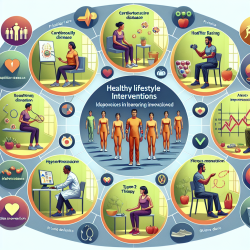Introduction
The prevalence of cardiovascular diseases (CVD) continues to rise globally, posing significant challenges to healthcare systems, particularly in low and middle-income countries. A recent study titled "Impact evaluation of a healthy lifestyle intervention to reduce cardiovascular disease risk in health centers in San José, Costa Rica and Chiapas, Mexico" offers valuable insights into addressing these challenges through group education interventions at primary care health centers. This blog explores the findings of this study and discusses how practitioners can leverage these insights to enhance their practice and improve patient outcomes.
Study Overview
The study, conducted between November 2011 and December 2012, involved a group education intervention aimed at reducing CVD risk among patients with hypertension and/or type 2 diabetes in San José, Costa Rica, and Chiapas, Mexico. The intervention consisted of six group education sessions focusing on lifestyle changes, including diet, physical activity, and disease management. Participants were followed for eight months, and the impact was assessed using a pretest-posttest comparison group design.
Key Findings
- In Costa Rica, significant improvements were observed in systolic and diastolic blood pressure, with borderline improvements in fasting glucose levels.
- In Chiapas, a significant dose-response relationship was found for blood pressure improvements, indicating that more frequent session attendance led to better outcomes.
- Both locations reported improvements in the stages-of-change measure, reflecting enhanced patient readiness to adopt healthier behaviors.
- No significant changes were noted in knowledge, self-efficacy, dietary behavior, or physical activity across both settings.
Implications for Practitioners
These findings underscore the potential of group education interventions to improve clinical outcomes and patient readiness for behavior change. Practitioners can consider the following strategies to enhance their practice:
- Tailored Interventions: Customize educational content to align with the cultural and contextual realities of the patient population, as demonstrated by the study's adaptation process.
- Engagement Strategies: Implement strategies to improve session attendance, such as flexible scheduling and addressing barriers to participation, to maximize intervention impact.
- Focus on Stages of Change: Emphasize interventions that enhance patient readiness to change, as this was a significant area of improvement in the study.
- Comprehensive Support: Consider incorporating family and community support systems to reinforce lifestyle changes and improve patient engagement.
Encouraging Further Research
While the study provides promising insights, further research is needed to explore the long-term impact of such interventions and the factors influencing patient adherence and engagement. Practitioners are encouraged to contribute to this body of research by evaluating the effectiveness of similar interventions in diverse settings and populations.
Conclusion
The study highlights the potential of group education interventions in primary care settings to improve clinical outcomes and patient readiness for lifestyle changes. By implementing tailored, culturally relevant interventions and engaging patients and their support systems, practitioners can enhance their practice and contribute to reducing the burden of cardiovascular diseases.
To read the original research paper, please follow this link: Impact evaluation of a healthy lifestyle intervention to reduce cardiovascular disease risk in health centers in San José, Costa Rica and Chiapas, Mexico.










